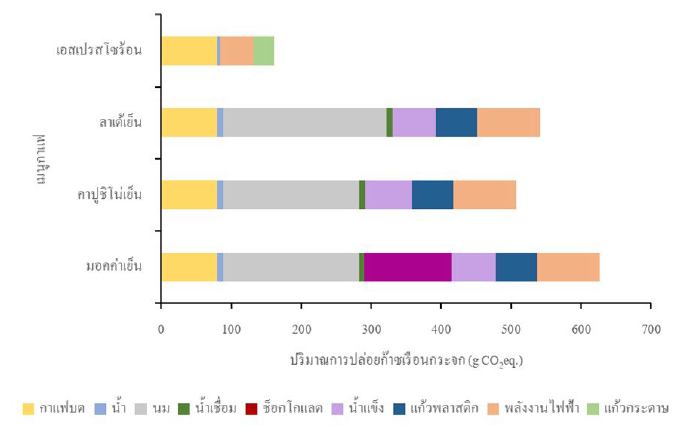Carbon Footprint of Coffee Drinks
Keywords:
Coffee drinks, Greenhouse gases, Carbon footprintAbstract
Coffee is a popular drink in many countries. The more consumption of coffee drinks, the more environmental impacts generated by their production and consimption. Other than pastic waste problem, the life cycle of coffee drinks also brings about greenhouse gas emissions that contribute to global warming. To provide the recommendations on the reduction of greenhouse gas emissions of coffee drinks, this study aimed at assessing and comparing the carbon footprint of coffee beverages, including mocha, cappuccino, latte, and espresso. Life cycle of the coffee beverages, covering raw material production, packaging, coffee making, and the disposal of baverage container were considered in this study. The results showed that the carbon footprint of a glass of mocha, cappuccino, latte, and espresso (in which 18 g ground coffee were equally used) were around 625, 506, 541 and 160 g CO2 equivalent, respectively. Raw materials with the highest greenhouse gas emissions were cow's milk and chocolate. This lead to the largest carbon footprint of mocha in which both cow’s milk and chocolate were used as the ingredients. Not only does the results of this study have an implication on the reduction of greenhouse gas emissions from coffee drinks, but also the method presented in this study can be a guideline for for other beverages’ carbon footprinting.
References
Cibelli, M., Cimini, A., Cerchiara, G.,& Moresi, M. (2021). Carbon footprint of different methods of coffee preparation. Sustainable Production and Consumption, 27, 1614-1625. https://doi.org/10.1016/j.spc.2021.04.004
Department of Agricultural Extension. (2014). Increase coffee production efficiency.The agricultural Co-operative Federation of Thailand., LTD.
Department of Business Development. (2019). Coffee production business. https://www.dbd.go.th/download/document_file/Statisic/2562/T26/T26_201901.pdf
Electricity Generating Authority of Thailand. (2021). Proportion of fuel use for generating electricity in the EGAT system in 2021. https://www.egat.co.th/index.php?option=com_content&view=article&id=2455&Itemid=116
Flysjö, A., Henriksson, M., Cederberg, C. Ledgard, S., & Englund, J. (2011). The impact of various parameters on the carbon footprint of milk production in New Zealand and Sweden. Agricultural Systems, 104, 459-469. https://doi.org/10.1016/j.agsy.2011.03.003
Harsono, S.S., Wibowo, R.K.K., &Supriyanto, E. (2021). Energy Balance and Green House Gas Emisson on Smallholder Java Coffee Production at Slopes Ijen Raung Plateau of Indonesia. Journal of Ecological Engineering, 22(7), 271-283. https://doi.org/10.12911/22998993/138997
Harst, E. v. d.,& Potting, J. (2013). A critical comparison of ten disposable cup LCAs. Environmental Impact Assessment Review, 43, 86-96.https://doi.org/10.1016/j.eiar.2013.06.006
Hassard, H. A., Couch, M. H., Techa-erawan, T.,& McLellan, B. C. (2014). Product carbon footprint and energy analysis of alternative coffee products in Japan. Journal of Cleaner Production, 1-12. https://doi.org/10.1016/j.jclepro.2014.02.006
Konstantas, A., Stamford, L.,& Azapagic, A. (2019). Evaluation of environmental sustainability of biscuits at the product and sectoral levels. Journal of Cleaner Production, 230, 1217-1228. https://doi.org/10.1016/j.jclepro.2019.05.095
Liblab, N. (2020). Carbon footprint assessment of dairy farm and dairy product in Phetchaburi college of agriculture and technology[Doctoral’s thesis,Silpakorn University].https://ithesis-ir.su.ac.th/dspace/bitstream/123456789/3379/1/59751301.pdf
Nab, C., &Maslin, M. (2020). Life cycle assessment synthesis of the carbon footprint of Arabica coffee: Case study of Brazil and Vietnam conventional and sustainable coffee production and export to the United Kingdom. Geography and Environment, 7(2), 96. https://doi.org/10.1002/geo2.96
National Food Institute. (2015). Coffee market inThailand. https://fic.nfi.or.th/MarketOverviewDomesticDetail.php?id=79
Newton Associate. (n.d.). ICEman IM-505U. https://icemancool.com/product/iceman-im-505u/
Prasatkhetkan, P.,& Chiarakorn, S. (n.d.). Carbon Footprint of Robusta Coffee Bean Processingin Community Enterprise.In the 34th the national graduate research conference(pp.327-340). KhonKaen University, KhonKaen.
Ratchawat, T., Panyatona, S., Nopchinwong, P., Chidthaisong, A., & Chiarakorn, S. (2020). Carbon and water footprint of Robusta cofee through its production chains in Thailand. Environment, Development and Sustainability, 22, 2415–2429. https://doi.org/10.1007/s10668-018-0299-4
Reay, D. (2019). Climate-Smart Food. https://doi.org/10.1007/978-3-030-18206-9
Thailand Greenhouse Gas Management Organization. (2019). Carbon Footprint PET Bottled Water Products. http://thaicarbonlabel.tgo.or.th/index.php?lang=TH&modWVhKMGFXTnNaUT09&action=WkdWMFlXbHM¶m=T1E9PQ
Thailand Greenhouse Gas Management Organization. (2021a). Carbon Footprint of Products. https://thaicarbonlabel.tgo.or.th/index.php?lang=TH&mod=Y0hKdlpImpkSE5mYVhNPQThailand Greenhouse Gas Management Organization. (2021b). Emission factors byindustry.https://thaicarbonlabel.tgo.or.th/admin/uploadfiles/emission/ts_b934985782.pdf
Thairath. (2021). Lab coffee is grown in trays for flavor. Sustainable drinking from the cup., https://plus.thairath.co.th/topic/futurism/100639
Thai News Network. (2021). "Coffee" culture hidden costs that hurt the world. https://today.line.me/th/v2/article/BjrQR6
Trinh, L.T.K., Hu, A.H., Lan, Y.C. &Chen, Z.H. (2019). Comparative life cycle assessment for conventional and organic coffee cultivation in Vietnam. International Journal of Environmental Science and Technology, 17, 1307–1324. https://doi.org/10.1007/s13762-019-02539-5
Universal Naming Covention. (2021). Natural gas.https://www.uac.co.th/th/knowledge-sharing/344/natural-gas

Downloads
Published
Issue
Section
Categories
License
Copyright (c) 2023 Journal of Applied Science and Emerging Technology

This work is licensed under a Creative Commons Attribution-NonCommercial-NoDerivatives 4.0 International License.

